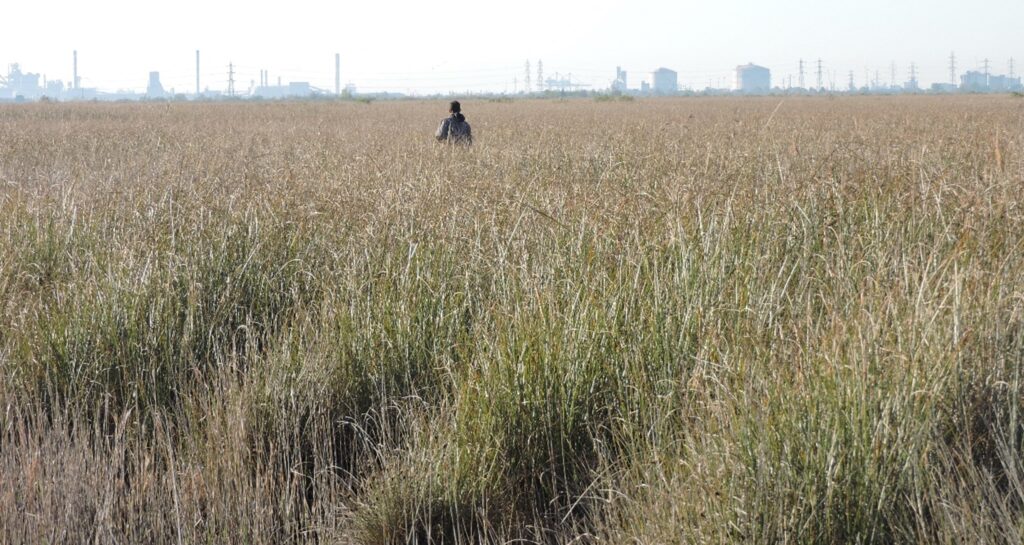Located in Camargue, south of the Vallée des Baux, the marshes of Port-Saint-Louis-du-Rhône cover more than 500 hectares. They consist partly of “marisque marshes,” i.e., covered with Cladium mariscus, a rare species of reed found in the Mediterranean coastal zone. These marshes are managed using an ancestral agricultural practice called “écobuage,” which involves burning the reeds to reopen the environment and encourage livestock grazing. However, the effects of this practice on nesting birds in the eelgrass marshes are poorly understood. The Camargue Regional Nature Park has entrusted A Rocha with the task of studying the effects of this practice on nesting birds.
Focus on slash-and-burn: fire as a pastoral management tool
Slash-and-burn is a method of managing open environments that is widely used across the globe, particularly to open up an environment or increase the pastoral resources available to livestock. This method is used in many types of habitats: from the grasslands of East Africa to the mountain scrublands of the Pyrenees, including Mediterranean scrubland and wetlands.
Fire has a significant impact on the flora and fauna of natural habitats that are burned, particularly on bird communities. However, this effect varies depending on the type of habitat affected. Numerous studies show an increase in the abundance and diversity of bird species immediately after a fire, followed by a rapid recovery to pre-fire levels. Conversely, other studies indicate a sharp decline in bird diversity and abundance, followed by a more or less rapid return to initial levels.
Our study site: the salt marshes of Port-Saint-Louis-du-Rhône
Salt marshes cover large areas within the marshes of the Baux Valley and the Arles marshes. In this area, they benefit from freshwater resurgence from the Crau aquifer. The Port-Saint-Louis-du-Rhône marshes are known for their large population of bitterns and rare marshland passerines. Locally, vegetation management is carried out by controlled burning, which has been organized for several years now using a fire rotation plan. Today, there is very little data on the effects of controlled burning on salt marshes and, to our knowledge, none on the effect of this management method on the bird communities nesting in this habitat.
The aim of the study was therefore to assess the impact of ecobuage on nesting birds in the salt marshes of Port-Saint-Louis-du-Rhône, and more specifically on:
– the bittern,
– three passerines: the bearded reedling, the local subspecies of the reed bunting Emberiza schoeniclus witherbyi, and the Savi’s warbler,
– the array of marshland passerines.

Butor étoilé (Emberiza schoeniclus) © Jamie Hall
Slash-and-burn farming has a significant impact on marsh birds
Our study shows that slash-and-burn farming has a significant impact on passerines. The species assemblages differ significantly between recently slash-burned plots and older ones. The abundance and diversity of passerines tend to increase with the age of the burn. However, other species present in the study area react differently. Burning favors the Reed Bunting. In contrast, the Bearded Reedling and the Savi’s Warbler only nest on plots that have been burned for more than three years.
A rotational burning plan allowing plots to rest for at least four years would be beneficial for the conservation of all marsh passerine species on the site. The large numbers of marsh passerines recorded and the population of bitterns make the conservation and proper management of the site major challenges for the conservation of these species in the south of France. In the future, scheduling regular annual or multi-year censuses would make it possible to track changes in the size of these populations and adapt management measures to benefit one species or another.
Discovery of a remarkable population of Reed Buntings
Our study also enabled us to identify the population of the local subspecies of Reed Bunting, which is characterized by its large beak. Known as “witherbyi,” this subspecies is only found in the south of France and Spain, where it is on the verge of extinction. With more than 100 breeding pairs, the Port-Saint-Louis marshes are likely home to the world’s largest population of this endangered subspecies, which represents a considerable conservation challenge for the site.
We hope that future studies will enable us to extend our surveys to adjacent marshes and implement a specific conservation plan for this subspecies.


https://shorturl.fm/MRMmR